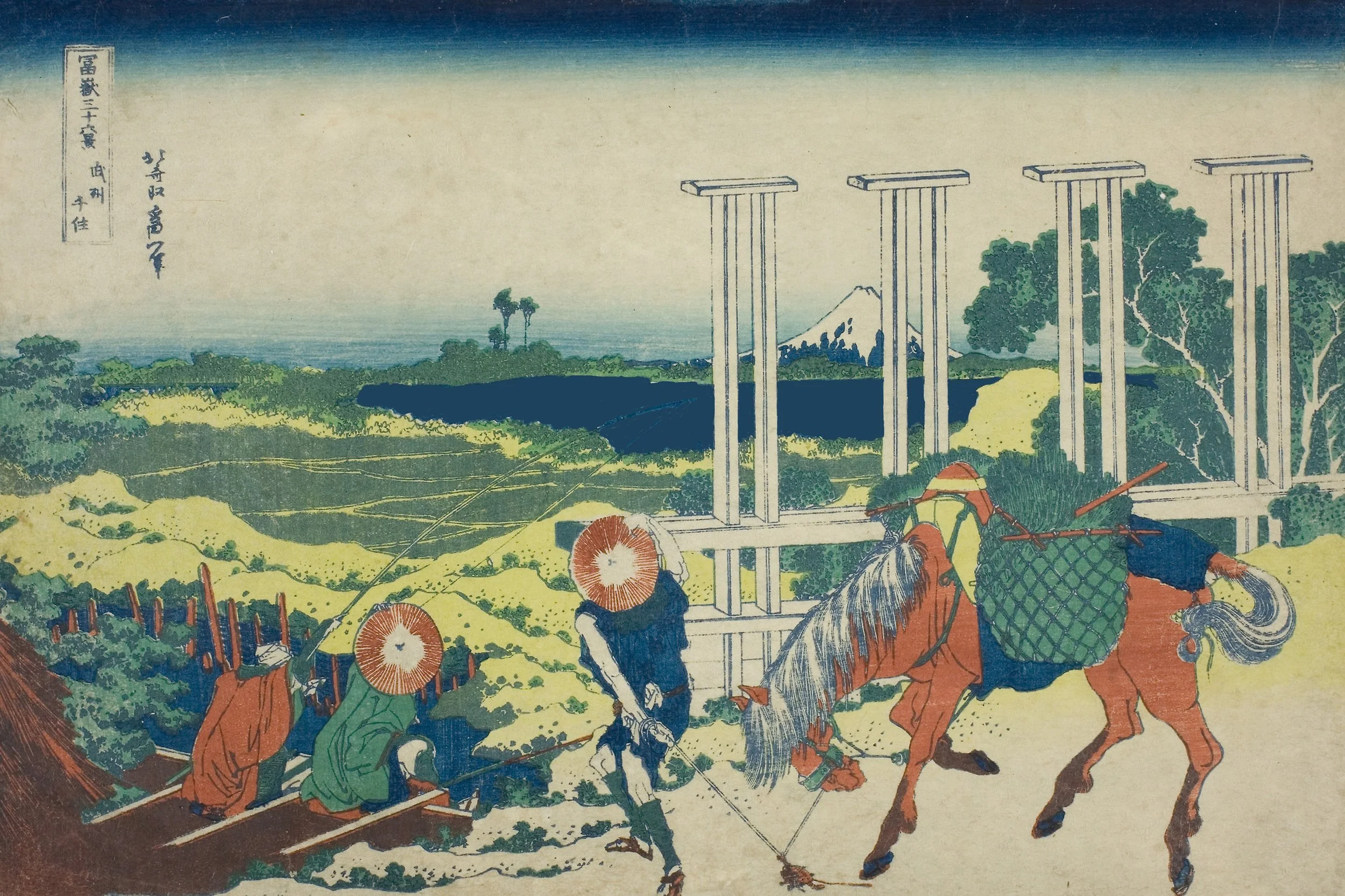7.Senjyu in the Musashi Province武州千住
Flowing across the composition is the Sumida River
In Hokusai’s time, it corresponded more closely to the modern-day Arakawa
And yet, that is the only element that stretches across the entire image
Uncharacteristically for Hokusai, the composition is split cleanly between left and right
On the right, a horse bursts to life, carrying bundles of Senju green onions
Behind it, a sluice gate channels water toward the rice fields
And in the distance, Mount Fuji stands watch
On the left, a packhorse driver leads the way
A fisherman casts his line in quiet solitude
Beyond them lie the paddies, and further still, a single tall tree—
the silent destination of every character’s gaze
Cover the left side
The right feels dense, even stifling
Cover the right side
The left feels vacant, unfocused
But together
The composition breathes
Balance emerges
The dense and the sparse held in perfect harmony
Who else could paint like this
One cannot help but marvel
Hokusai, the composer of space
Herein lies Hokusai’s discerning eye for beauty
04
8.Cusion Pine at Aoyama 青山圓座枩
Aoyama Enza Pine.
Harajuku Village, Ryuganji Temple—
abolished during the Meiji era's anti-Buddhist movement.
Almost no records remain
around what is now Harajuku Station.
Aoyama Enza Pine.
Ryuganji Temple was famed
for the Enza Pine,
a scenic tree that offered a place in its shade—
a circle for sitting,
a space for gathering.
Hokusai drew it low,
and curiously spherical.
A pine shaped like a ball is rare.
It was likely pruned that way.
Yet the sheer number of pines,
each so meticulously shaped,
is hard to believe.
The mound beneath the tree—
as shown in Aoyama Enza Pine—
is likely man-made.
Harajuku’s terrain is flat;
no such hill naturally exists.
Fujisan worship gave rise
to miniature mountains for those
who could not climb the real one.
These were called Fujizuka—
small replicas for spiritual ascent.
Naturally, they took the form
of a cone.
But no record tells
of Fuji cults thriving in Harajuku.
If, by chance,
that mound were a Fujizuka,
Hokusai may have boldly
rendered it dome-shaped.
Or perhaps,
it had always been a dome.
Either way,
the mound formed by pine trees
bulges forward—
a convex shape
set in visual contrast
against the concave silhouette
of Mt. Fuji behind.
Hokusai would never choose
a comparison of similar shapes.
Convex and concave—
now that is striking.
A spherical pine
is the perfect unit
for constructing a convex hill.
It catches light and shadow,
maximizing depth and dimension.
Surely, it was Hokusai
who rendered every pine
into a sphere.
Hokusai does not paint
what he sees.
He paints what he envisions.
The spherical pines,
the mound they create—
they exist only
within the mind of Hokusai.
Aoyama Enza Pine
is the ultimate feat
of graphic design.
A composition imagined—
surpassing reality.
Herein lies Hokusai’s discerning eye for beauty.

